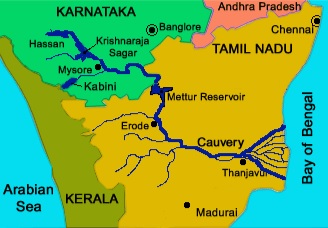Cauvery Water Sharing Dispute | 19 Aug 2023
For Prelims: Cauvery and its tributary Arkavathi, Cauvery Water Disputes Tribunal, Central Water Commission (CWC)
For Mains: Interstate water disputes, Diplomacy in resolving interstate water disputes, Water governance
Why in News?
The Cauvery water dispute has once again taken center stage, as Tamil Nadu appeals to the Supreme Court of India for intervention in ensuring the release of 24,000 cubic feet per second (cusecs) from its reservoir's water by Karnataka.
- Tamil Nadu also urged the Court to direct Karnataka to ensure the release of 36.76 TMC (thousand million cubic feet) stipulated for September 2023 as per the Cauvery Water Disputes Tribunal (CWDT)’s final award of February 2007 that was modified by the SC in 2018.
What Led to Tamil Nadu's Appeal to the Supreme Court?
- Tamil Nadu's Appeal to SC:
- The issue arose from Karnataka's refusal to abide by previously agreed-upon water release quantities.
- Tamil Nadu advocates for the release of 10,000 cusecs of water for the stipulated 15-day duration. On the other hand, Karnataka has suggested a reduced water release of 8,000 cusecs for the same 15-day timeframe.
- The issue arose from Karnataka's refusal to abide by previously agreed-upon water release quantities.
- Karnataka's Explanation:
- Karnataka cites poor inflow due to reduced rainfall in Cauvery catchment, including origin point Kodagu.
- Karnataka highlights a 44% rainfall deficit in Kodagu from June to August.
- Karnataka rejects Tamil Nadu's distress-sharing formula demand.
- Karnataka cites poor inflow due to reduced rainfall in Cauvery catchment, including origin point Kodagu.
- Implications:
- Tamil Nadu's farmers await Karnataka's response, as the Mettur reservoir holds only 20 TMC, lasting ten days.
- The Supreme Court's decision holds significance in resolving the complex dispute.
- Collaborative solutions are crucial for equitable water management and conflict resolution.
How is the Cauvery Water Being Shared?
- A carefully crafted monthly schedule governs the distribution of water between Karnataka and Tamil Nadu, the two riparian states of the Cauvery basin.
- In a "normal" water year, Karnataka is bound to release 177.25 TMC (thousand million cubic feet) of water from June to May to Tamil Nadu.
- This annual quota includes 123.14 TMC allocated during the monsoon months from June to September.
- The ongoing southwest monsoon season often triggers disputes when rainfall falls short of expectations.
What is the Cauvery River Dispute?
- River Cauvery (Kaveri):
- It is known as ‘Ponni’ in Tamil and is a sacred river of southern India.
- It rises on Brahmagiri Hill of the Western Ghats in southwestern Karnataka state, flows in a southeasterly direction through the states of Karnataka and Tamil Nadu, and descends the Eastern Ghats in a series of great falls and drains into Bay of Bengal through Pondicherry.
- Left Bank Tributary: Arkavathi, Hemavathi, Shimsa, and Harangi.
- Right Bank Tributary: Lakshmantirtha, Suvarnavati, Noyil, Bhavani, Kabini, and Amaravathi.
- The Dispute:
- As the river originates in Karnataka, flows through Tamil Nadu with major tributaries coming from Kerala and drains into the Bay of Bengal through Pondicherry the dispute therefore involves 3 states and one Union Territory.
- The genesis of the dispute is 150 years old and dates back to the two agreements of arbitration in 1892 and 1924 between the then Madras presidency and Mysore.
- It entailed the principle that the upper riparian state must obtain consent of lower riparian state for any construction activity viz. reservoir on the river Cauvery.
- The Cauvery water dispute between Karnataka and Tamil Nadu began in 1974 when Karnataka started diverting water without Tamil Nadu's consent.
- After several years, the Cauvery Water Disputes Tribunal (CWDT) was established in 1990 to resolve the issue. It took 17 years for the CWDT to reach a final order in 2007, which outlined the sharing of Cauvery water among the four riparian states. In distress years, water would be shared on a pro-rata basis.
- CWDT issued its final award in February 2007, specifying water allocations among the four states in the Cauvery basin, considering the total availability of 740 TMC in a normal year.
- The allocation of water among the four states is as follows: Tamil Nadu - 404.25 TMC, Karnataka - 284.75 TMC, Kerala - 30 TMC, and Puducherry - 7 TMC.
- In 2018, the Supreme Court declared the Cauvery a national asset and largely upheld the water-sharing arrangements determined by the CWDT.
- It also directed the Centre to notify the Cauvery Management Scheme.
- The central government notified the ‘Cauvery Water Management Scheme’ in June 2018, constituting the ‘Cauvery Water Management Authority’ and the ‘Cauvery Water Regulation Committee’.
UPSC Civil Services Examination, Previous Year Question (PYQ)
Prelims
Q. Which of the following Protected Areas are located in Cauvery basin? (2020)
- Nagarhole National Park
- Papikonda National Park
- Sathyamangalam Tiger Reserve
- Wayanad Wildlife Sanctuary
Select the correct answer using the code given below:
(a) 1 and 2 only
(b) 3 and 4 only
(c) 1, 3 and 4 only
(d) 1, 2, 3 and 4
Ans: (c)
Mains
Q. Constitutional mechanisms to resolve the inter-state water disputes have failed to address and solve the problems. Is the failure due to structural or process inadequacy or both? Discuss. (2013)

